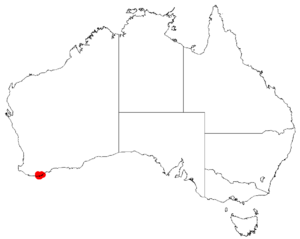Albany cone bush facts for kids
Quick facts for kids Albany cone bush |
|
|---|---|
| Conservation status | |
| Scientific classification | |
| Genus: |
Isopogon
|
| Species: |
uncinatus
|
 |
|
| Occurrence data from Australasian Virtual Herbarium | |
| Synonyms | |
|
|
The Isopogon uncinatus, also known as the Albany cone bush, is a special type of flowering plant. It belongs to the Proteaceae family, which includes many unique Australian plants. This plant is only found in a small area near Albany in Western Australia.
The Albany cone bush is a small shrub. It has very short stems and interesting leaves that can be long and narrow. Its flowers are yellowish and grow in round clusters. This plant is super rare! For a while, people thought it had completely disappeared, but it was found again in the 1980s.
What it Looks Like
The Albany cone bush is a shrub that spreads out. It usually grows to be about 30 to 50 centimeters (about 1 to 1.5 feet) tall and wide. Its branches are very short and covered in brownish hairs.
The leaves of this plant are quite long, from 8 to 32 centimeters (about 3 to 12 inches) in length. They are narrow, usually 3 to 9 millimeters wide. Often, the tip of the leaf has a small hook, especially when the plant is young.
The flowers are yellowish and grow in round heads. These flower heads are about 2.5 to 3 centimeters (about 1 inch) across. They are found close to the base of the plant, surrounded by leaves. Each flower can be up to 2.5 centimeters long. The flowers are smooth near the bottom but become very silky and hairy towards the tip. You can usually see this plant flowering in October. After flowering, it produces hairy nuts that are joined together in a round head, about 1.2 centimeters (half an inch) wide.
Its Name and History
The Albany cone bush was first officially described in 1830. A famous botanist named Robert Brown gave it its scientific name, Isopogon uncinatus. He wrote about it in a book called Supplementum. The plant material he used to describe it was collected by William Baxter near King George's Sound.
The second part of its scientific name, uncinatus, is a Latin word. It means "hooked," which refers to the hooked tips often found on its leaves.
Where it Lives
The Albany cone bush grows in a specific type of forest. It likes areas with short jarrah trees and bushes. You can find it in swampy areas or on hillsides near Albany in Western Australia.
This plant is very rare. It is only known to exist in nine small groups of plants.
Why it's Important to Protect It
This is the rarest type of Isopogon plant. People thought it was extinct, meaning it had completely died out, until it was rediscovered in the 1980s.
Today, the Albany cone bush is listed as "critically endangered." This means it is in very serious danger of disappearing forever. The Australian Government has laws, like the Environment Protection and Biodiversity Conservation Act 1999, to protect it. The local Department of Environment and Conservation also lists it as "Threatened Flora."
There are a few main things that threaten this special plant:
- Disease: A plant disease caused by something called Phytophthora cinnamomi can harm it.
- Fires: Fires that happen at the wrong time or are too strong can damage the plants.
- Drought: Long periods of very dry weather can also make it hard for the plant to survive.


